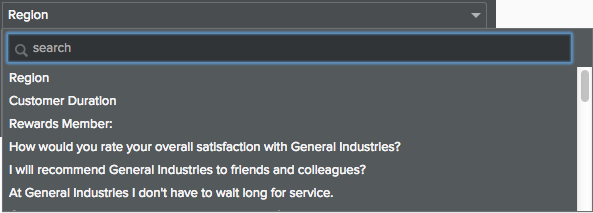
If you are going to define more than one criterion, decide on the logic you want to use to connect them. Do so by selecting ANY or ALL:


In boolean terms, ANY = OR and ALL = AND. For our example we will choose "ANY".
Define your first criterion. A criterion is equal to a trigger that causes an action. It consists of three parts: a question, a logical connector, and an answer value. A criterion can stand alone or be joined with other criteria through and/or logic.
Take these sub-steps to define it:
Step 2a
Choose the question you want to use as the basis for the criterion. Many times this can be something like a ranking or other numerical rating question (slider, stars, radio button, etc.) that asks the respondent to evaluate their experience with your company:

In this case we will use the question "Rate your overall experience with General Industries."
Step 2b
Define the criterion logic. The available operators depend on the type of question you chose.
In this case choose "Equals" or "Doesn't Equal". For our example we will select "Equals".

This choice represents two slightly different ways of defining the criterion, which become clearer with the next step.
Step 2c
Set the threshold value for the action. This equates to the answer or answers to the question that will cause the action to be triggered:

For this example we will choose "Unacceptable" or "Acceptable". Thus, the entire logical string is this:
The case creation criterion evaluates to "True" if the answer to the question "Rate your overall experience with General Industries" equals "Unacceptable" or "Acceptable".
Had we chosen the logical connector "Doesn't Equal", we might have selected the answers "Excellent" or "Very Good", which instead would have given us this logic:
The case creation criterion evaluates to "True" if the answer to the question "Rate your overall experience with General Industries" doesn't equal "Very Good" or "Excellent".
When you have finished defining the criterion, click Done.
Step 3
Use the plus button  to add any additional criteria, using the procedure described in Step
2. Remember that these will be linked with the logical connector you
selected in Step 1. For our example we will define
our second criterion like this:
to add any additional criteria, using the procedure described in Step
2. Remember that these will be linked with the logical connector you
selected in Step 1. For our example we will define
our second criterion like this:
The case creation criterion evaluates to "True" if the answer to the question "How likely are you to recommend General Industries" equals "Very Unlikely" or "Somewhat Unlikely".
Connected with the "OR" logic we chose in Step 1, the entire logical statement we have defined thus comes out like this:
A case will be created if the answer to the question "Rate your overall experience with General Industries" equals "Unacceptable" or "Acceptable" OR the answer to the question "How likely are you to recommend General Industries" equals "Very Unlikely" or "Somewhat Unlikely".
This is represented through the user interface like this:

You can add as many criteria as needed to define the trigger.
Note: If you define too many criteria, it may result in never triggering the action. If you create too few criteria, you may trigger the action more than is desirable.